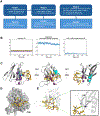NMR-Guided Studies to Establish the Binding Interaction between a Peptoid and Protein
- PMID: 40663344
- PMCID: PMC12310119
- DOI: 10.1021/jacs.5c04064
NMR-Guided Studies to Establish the Binding Interaction between a Peptoid and Protein
Abstract
Ligand discovery of nonenzymatic proteins can be accomplished through screening methods utilizing libraries comprising small molecules, peptides, and peptidomimetics. Incorporating peptoids, which are oligomers of N-substituted glycine monomers, into high-throughput screens can produce libraries of large structural diversity. Due to their malleable structures, peptoids can occupy unique protein binding sites, but determination of the peptoid binding pose is challenging. For example, the peptoid KDT-11 is reported to bind with low micromolar binding affinity to the proteasome subunit Rpn-13. Poor solubility of initial compound screening hits, like KDT-11, can greatly hinder progress in drug discovery since it limits in vitro characterization. The work reported here overcomes this hurdle with the addition of a solubility tag to KDT11, enabling elucidation of the biologically relevant surface of the peptoid through a variety of structure-activity relationships and biophysical studies. NMR paramagnetic relaxation data guided a structural modeling protocol using multiple molecular dynamics (MD) trajectories and extensive sampling. The final peptoid-protein structure is conformationally stable in equilibrium MD trajectories for >1 μs time period. KDT-11 binds across the β6/β7/β8 strands and α-helix of Rpn-13, revealing an interface for inhibition that could be targeted in future computational drug discovery efforts to obtain more potent ligands for Rpn-13. It is reasonable that the methodology described here can extend to other flexible peptoid or peptide ligands in complexes with proteins.
Figures




Similar articles
-
Structure-function relationship within helical peptoids for Cu2+ chelation in the context of Alzheimer's disease.J Inorg Biochem. 2025 Oct;271:112961. doi: 10.1016/j.jinorgbio.2025.112961. Epub 2025 May 28. J Inorg Biochem. 2025. PMID: 40466273
-
Approaches to Evaluate the Impact of a Small-Molecule Binder to a Noncatalytic Site of the Proteasome.Chembiochem. 2021 Jun 2;22(11):1961-1965. doi: 10.1002/cbic.202100023. Epub 2021 Mar 26. Chembiochem. 2021. PMID: 33617657 Free PMC article.
-
Management of urinary stones by experts in stone disease (ESD 2025).Arch Ital Urol Androl. 2025 Jun 30;97(2):14085. doi: 10.4081/aiua.2025.14085. Epub 2025 Jun 30. Arch Ital Urol Androl. 2025. PMID: 40583613 Review.
-
Short-Term Memory Impairment.2024 Jun 8. In: StatPearls [Internet]. Treasure Island (FL): StatPearls Publishing; 2025 Jan–. 2024 Jun 8. In: StatPearls [Internet]. Treasure Island (FL): StatPearls Publishing; 2025 Jan–. PMID: 31424720 Free Books & Documents.
-
[Volume and health outcomes: evidence from systematic reviews and from evaluation of Italian hospital data].Epidemiol Prev. 2013 Mar-Jun;37(2-3 Suppl 2):1-100. Epidemiol Prev. 2013. PMID: 23851286 Italian.
References
-
- Lam KS; Salmon SE; Hersh EM; Hruby VJ; Kazmierski WM; Knapp RJ A New Type of Synthetic Peptide Library for Identifying Ligand-Binding Activity. Nature 1991, 354 (6348), 82–84. - PubMed
-
- Lebl M; Krchňák V; Sepetov NF; Seligmann B; Štrop P; Felder S; Lam KS One-bead–One-structure Combinatorial Libraries. Biopolymers: Original Research on Biomolecules 1995, 37 (3), 177–198. - PubMed
-
- Liu R; Marik J; Lam KS A Novel Peptide-Based Encoding System for “One-Bead One-Compound” Peptidomimetic and Small Molecule Combinatorial Libraries. Journal of the American Chemical Society 2002, 124 (26), 7678–7680. - PubMed
-
- Zuckermann RN Peptoid Origins. Peptide Science 2011, 96 (5), 545–555. - PubMed
-
- Yoo B; Kirshenbaum K Peptoid Architectures: Elaboration, Actuation, and Application. Current opinion in chemical biology 2008, 12 (6), 714–721. - PubMed
MeSH terms
Substances
Grants and funding
LinkOut - more resources
Full Text Sources

